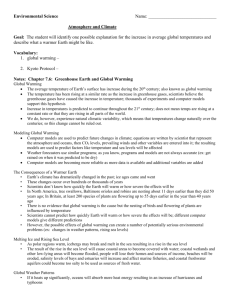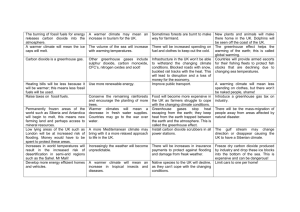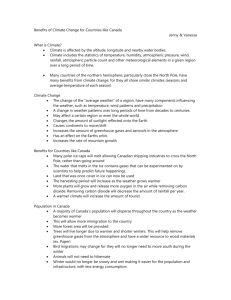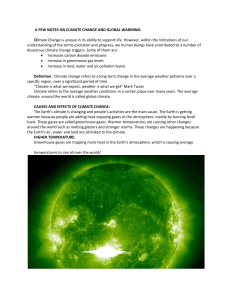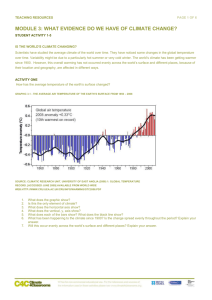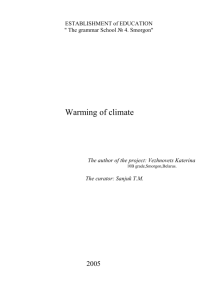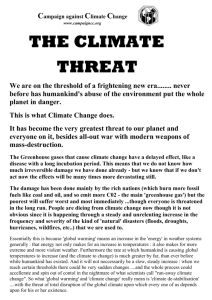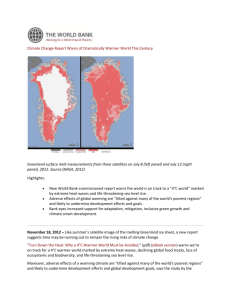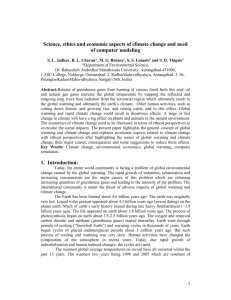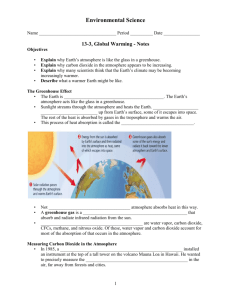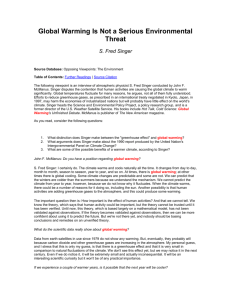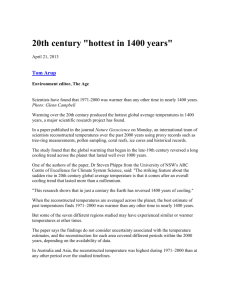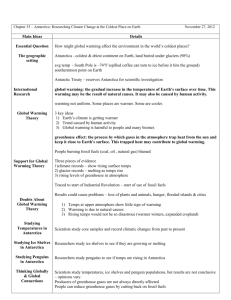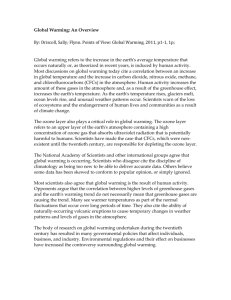Environmental Science Name: Atmosphere and Climate Goal: The
advertisement
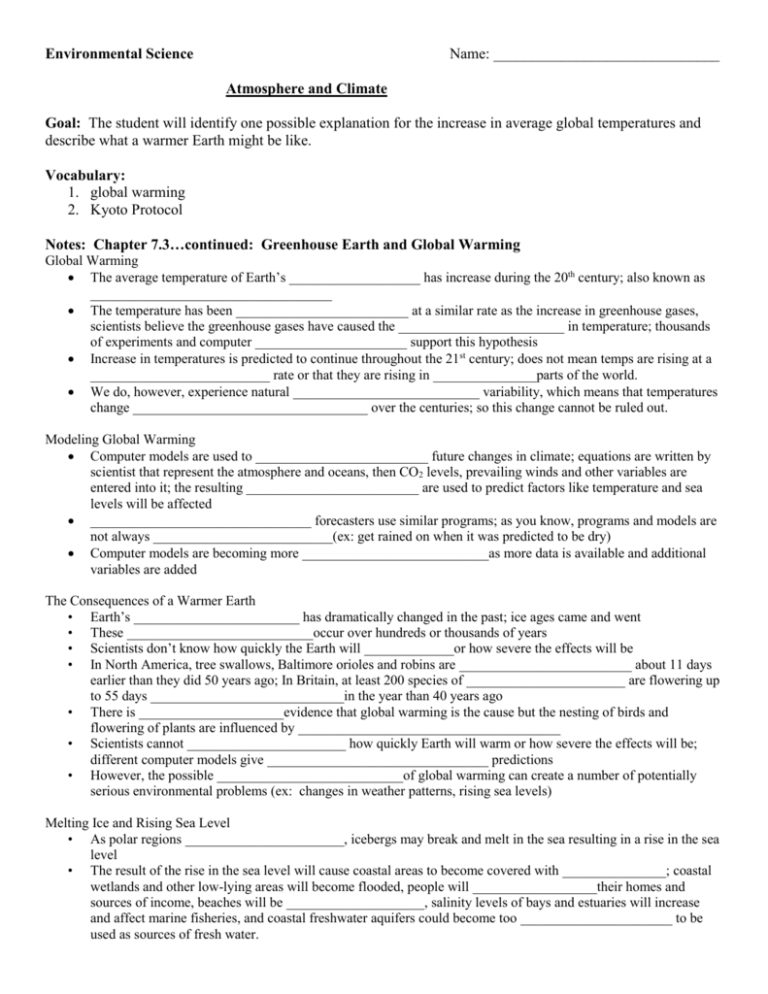
Environmental Science Name: ______________________________ Atmosphere and Climate Goal: The student will identify one possible explanation for the increase in average global temperatures and describe what a warmer Earth might be like. Vocabulary: 1. global warming 2. Kyoto Protocol Notes: Chapter 7.3…continued: Greenhouse Earth and Global Warming Global Warming The average temperature of Earth’s ___________________ has increase during the 20th century; also known as ___________________________________ The temperature has been _________________________ at a similar rate as the increase in greenhouse gases, scientists believe the greenhouse gases have caused the ________________________ in temperature; thousands of experiments and computer ______________________ support this hypothesis Increase in temperatures is predicted to continue throughout the 21st century; does not mean temps are rising at a __________________________ rate or that they are rising in _______________parts of the world. We do, however, experience natural ___________________________ variability, which means that temperatures change __________________________________ over the centuries; so this change cannot be ruled out. Modeling Global Warming Computer models are used to _________________________ future changes in climate; equations are written by scientist that represent the atmosphere and oceans, then CO2 levels, prevailing winds and other variables are entered into it; the resulting _________________________ are used to predict factors like temperature and sea levels will be affected ________________________________ forecasters use similar programs; as you know, programs and models are not always __________________________(ex: get rained on when it was predicted to be dry) Computer models are becoming more ___________________________as more data is available and additional variables are added The Consequences of a Warmer Earth • Earth’s ________________________ has dramatically changed in the past; ice ages came and went • These ___________________________occur over hundreds or thousands of years • Scientists don’t know how quickly the Earth will _____________or how severe the effects will be • In North America, tree swallows, Baltimore orioles and robins are _________________________ about 11 days earlier than they did 50 years ago; In Britain, at least 200 species of _______________________ are flowering up to 55 days ____________________________in the year than 40 years ago • There is _____________________evidence that global warming is the cause but the nesting of birds and flowering of plants are influenced by ______________________________________ • Scientists cannot _______________________ how quickly Earth will warm or how severe the effects will be; different computer models give ________________________________ predictions • However, the possible ___________________________of global warming can create a number of potentially serious environmental problems (ex: changes in weather patterns, rising sea levels) Melting Ice and Rising Sea Level • As polar regions _______________________, icebergs may break and melt in the sea resulting in a rise in the sea level • The result of the rise in the sea level will cause coastal areas to become covered with _______________; coastal wetlands and other low-lying areas will become flooded, people will __________________their homes and sources of income, beaches will be ____________________, salinity levels of bays and estuaries will increase and affect marine fisheries, and coastal freshwater aquifers could become too ______________________ to be used as sources of fresh water. Global Weather Patterns • If it ____________________ up significantly, oceans will __________________ more heat energy resulting in an increase of hurricanes and typhoons • Scientists are concerned about changes in _______________________ current patterns if there are changes in the world’s weather; some areas may get more _________________ (flooding) than normal and other areas may get even __________________ (severe droughts) Human Health Problems Warmer ___________________________ global temperatures pose potential threats to human health Greater numbers of ___________________________ related deaths could occur; very young and very old city dwellers are at the greatest risk during heat waves People with ______________________________ to pollen would suffer more as a result of the increase in growing time for flowering plants Warmer and longer summers could allow _____________________________ to establish themselves in areas which are too ________________ for them now (ex: bring diseases like malaria, dengue fever and encephalitis) Agriculture • Agriculture will be greatly affected if there are _____________________ weather changes • Some of the most _____________________________, productive areas may get hotter and drier resulting in a shift northward for farming rather than the areas where ________________________________ is prevalent today • We would see _____________________ crops yields and higher demand for irrigation, further depleting aquifers Effects on Plants and Animals Climate change could alter _______________________ the range of plant species and the composition of plant communities; trees colonizing cooler areas, forest could ___________________ in the warmer part of their range, lose of _________________________________ Could cause a shift in the geographical range of some _______________________ (ex: migrating birds may not have to go as far south for winter, warm surface water in the ocean might cause a reduction in zooplankton, and warming in tropical waters may kill the algae that nourish corals, killing the coral reefs) Recent Findings Intergovernmental Plan on Climate Change (IPCC) is a network of about 2,500 of the world’s leading ___________________________________ from 70 countries; they provide future estimates about the state of the global climate system Findings have included: the average global _________________________ temperatures have increases by 0.6 degrees C during the 20th century, snow cover and ice extent have ________________________ and average global sea level has risen They also have reported that atmospheric greenhouse gases have continued to ___________________ as a result of human activities and predict that human influences will continue to ________________________ the composition of the Earth’s atmosphere throughout the 21st century Reducing the Risk In 1997, representative from _____________________countries met and set timetables for reducing emissions of greenhouse gases; this treaty is called the _______________ Protocol (ratified by 55% of the attending nations) Kyoto Protocol requires developed countries to _________________________ emissions of carbon dioxide and other greenhouse gases by an average of 5% below their 1990 levels by 2012; US decided not to ratify the Kyoto Protocol. Slowing the Temperature Change • How can we slow down global warming? • Use ___________________ fossil fuels will lessen the release of carbon dioxide into the atmosphere • Preserve Earth’s existing forests and plant more trees; this will help remove carbon dioxide from the atmosphere • Limit __________________________________ gas emissions Lesson Reflection: Assessment: 1. Explain why carbon dioxide in the atmosphere is increasing. 2. Name some of the possible consequences of a warmer Earth. Active Reading: Global Warming Lesson Extension (Technology/Application/Connection to Real World): Finish watching: Six Degrees the Change the World (parts 3 degrees to 6 degrees)
